Oktoba . 10, 2024 18:06 Back to list
Non-Rising Stem Gate Valves Features and Applications Explained
Understanding Non-Rising Gate Valves A Mechanical Perspective
Non-rising gate valves are a vital component in the control and regulation of fluid flow within various industrial applications. Unlike traditional rising stem gate valves, non-rising gate valves are designed with a distinct mechanism that does not cause the stem to extend out of the valve body as it opens or closes. This feature provides several advantages in terms of space constraints, versatile applications, and reliability.
Design and Functionality
The primary function of a gate valve is to facilitate the on/off flow control in a pipeline. In the case of non-rising gate valves, the gate itself moves parallel to the flow direction, ensuring minimal obstruction and a straight-through flow path. This design allows for less turbulence and a more efficient flow of fluids, whether they are liquids or gases. The absence of a rising stem means that the valve can be installed in situations where vertical space is limited, such as underground piping systems or within tight mechanical spaces.
The valve operates using a handwheel or actuator connected to the valve stem. When the handwheel is turned, the stem rotates, moving the gate up or down, engaging or disengaging the flow. This simplicity not only makes non-rising gate valves easy to operate but also reduces the potential for mechanical failure compared to more complex valving mechanisms.
Applications
Non-rising gate valves find extensive use in various sectors, including water treatment facilities, oil and gas industries, power plants, and chemical processing. Their compact design makes them particularly suitable for locations with limited overhead space, such as basements or underground installations. Additionally, they are often used in systems where the valve must remain submerged, as the non-rising feature prevents any obstruction that may occur from the stem moving outside the valve body.
In many applications, these valves are preferred for their ability to provide a tight seal. When fully closed, the gate forms a barrier that can withstand significant pressure, making it ideal for high-pressure applications. Moreover, non-rising gate valves are known for their durability, as they are often constructed from robust materials such as stainless steel, brass, or ductile iron, allowing them to handle corrosive environments effectively.
gate valve non rising

Advantages Over Rising Stem Valves
One significant advantage of non-rising gate valves over their rising-stem counterparts is their space-saving design. Because the stem is contained entirely within the valve body, there is no need for additional clearance above the valve. This feature allows for easy installation in locations where height is a constraint, such as under bridges or in crowded mechanical rooms.
Furthermore, non-rising gate valves require less maintenance. Traditional rising stem designs can experience issues with stem wear and the potential for leaks at the packing. Non-rising valves mitigate these concerns by keeping all moving parts contained within the body of the valve, reducing exposure to environmental factors and wear over time.
Limitations and Considerations
While non-rising gate valves offer many benefits, they are not without their limitations. One of the critical considerations when choosing this type of valve is the need for adequate space for the actuator or handwheel. Unlike rising stem valves that visibly indicate whether they are open or closed, non-rising gate valves may require additional means for monitoring their position unless equipped with position sensors.
Moreover, in applications where frequent cycling is required, non-rising gate valves may not be the best choice. Their design is optimized for on/off service rather than throttling or regulating flow. In such cases, alternative valves, like globe or ball valves, may be more suitable.
Conclusion
In summary, non-rising gate valves are an essential component of fluid control systems, offering numerous benefits such as space efficiency, reliability, and ease of operation. Their unique design makes them ideally suited for various applications, particularly where height constraints exist. However, as with any mechanical device, it is essential to weigh the advantages against potential limitations to determine the most suitable valve type for a specific application. Understanding these factors can lead to better decision-making and enhanced operational efficiency in fluid management systems.
Share
-
Reliable Wafer Type Butterfly Valves for Every IndustryNewsJul.25,2025
-
Reliable Flow Control Begins with the Right Ball Check ValveNewsJul.25,2025
-
Precision Flow Control Starts with Quality ValvesNewsJul.25,2025
-
Industrial Flow Control ReliabilityNewsJul.25,2025
-
Engineered for Efficiency Gate Valves That Power Industrial PerformanceNewsJul.25,2025
-
Empowering Infrastructure Through Quality ManufacturingNewsJul.25,2025